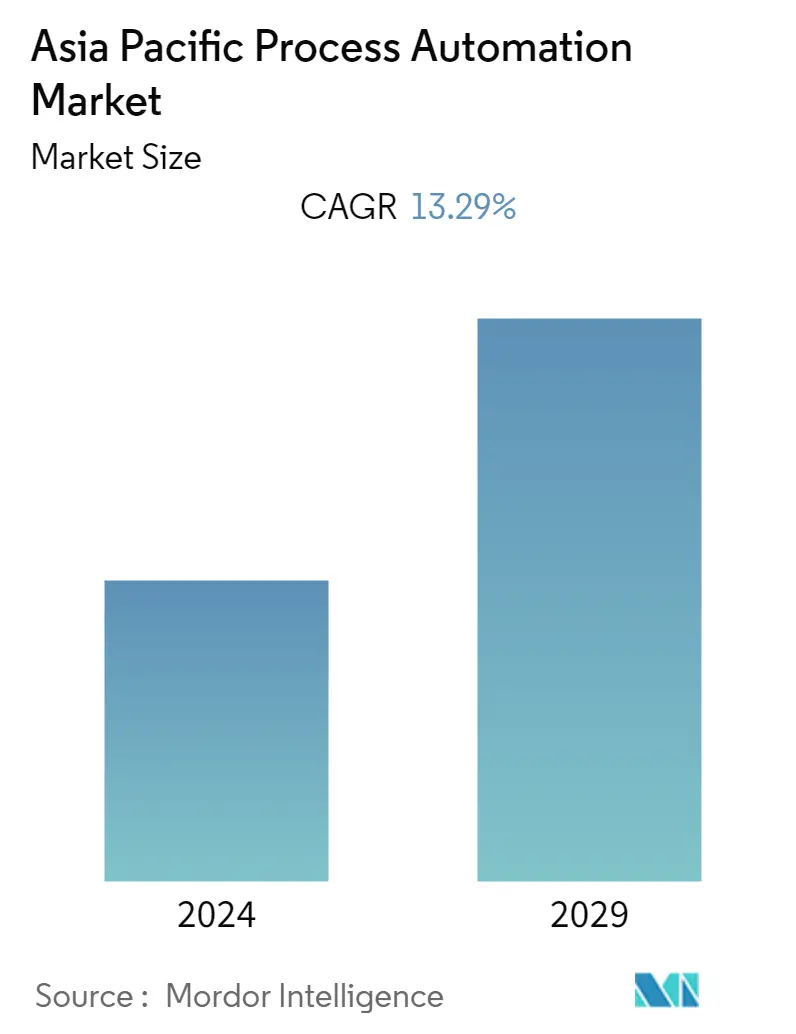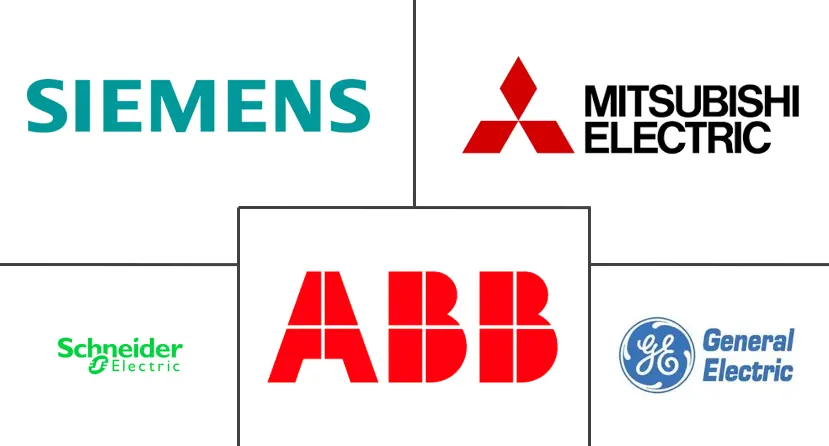Market Size of Asia Pacific Process Automation Industry

| Study Period | 2019 - 2029 |
| Base Year For Estimation | 2023 |
| Forecast Data Period | 2024 - 2029 |
| Historical Data Period | 2019 - 2022 |
| CAGR | 13.29 % |
| Market Concentration | Low |
Major Players
*Disclaimer: Major Players sorted in no particular order |
APAC Process Automation Market Analysis
The Asia Pacific Process Automation Market is expected to witness a CAGR of 13.29% over the forecast period 2021 - 2026. The COVID-19 pandemic created economic turmoil for small, medium, and large-scale industries across the world. Additionally, country-wise lockdown inflicted by the governments worldwide to minimize the spread of the virus impacted the growth of enterprises.
- The automation industry has been revolutionized by combining the digital and physical aspects of manufacturing, aiming to deliver optimum performance. Further, the focus on achieving zero waste production and shorter time to market has augmented the market's growth.
- Automation of manufacturing processes has offered various benefits, such as effortless monitoring, reduction of waste, and production speed. This technology offers customers an improved quality with standardization and dependable products within time and at a much lower cost.
- Connecting the industrial machinery and equipment and obtaining real-time data have played a vital role in the adoption of SCADA, HMI, PLC systems, and software that offer visualization; thus enables reducing the faults in the product, reducing downtime, scheduling maintenance, and switching from being in the reactive state to predictive and prescriptive stages for decision-making.
- Moreover, the virtualization of automation control systems is a key trend observed in the market, also known as the thin layer between the virtual machine and host server. The virtual machine contains the operating system and software. Different operating systems are operated on top of a primary operating system using virtual machines. Virtualization can be applied on layers in an industrial premise, such as server, storage, desktop, file, and network. It provides benefits, such as optimum resource utilization and operation, as well as power cost savings.
- Vendor activity, such as product innovations, strategic mergers, and acquisitions, etc., taking place in the space is expected to drive the demand. New products are considered as the primary activity. In May 2020, OleumTech, wireless industrial automation, and IoT solution provider announced the launch of new smart pressure transmitters (HGPT smart gauge pressure transmitters).
- Further, different industrial automation systems, such as SCADA, PLCs, and MES on a single physical server, can be easily accessed at a different location on the plant floor using virtual machines. It has been adopted to reduce the overall cost for servers and increase the flexibility in adopting industrial automation systems and software in the process and discrete industries.
APAC Process Automation Industry Segmentation
The study characterizes the process automation market based on the system type, end-user industry, and country. The study describes the process automation market based on the technology type, a communication protocol that includes wired and wireless protocol, System type, end-user industry, and country. Further, the study comprises Software & Services and the impact of COVID-19 on the market.
| By Communication Protocol | |
| Wired | |
| Wireless |
| By System Type | |||||||||||
| |||||||||||
|
| By End-user Industry | |
| Oil and Gas | |
| Chemical and Petrochemical | |
| Power and Utilities | |
| Water & Wastewater | |
| Food and Beverage | |
| Paper & Pulp | |
| Pharmaceutical | |
| Other End-user Industries |
| By Country | |
| China | |
| India | |
| Japan | |
| Rest of Asia Pacific |
Asia Pacific Process Automation Market Size Summary
The Asia Pacific Process Automation Market is experiencing significant growth, driven by the integration of digital and physical manufacturing processes. This evolution aims to enhance performance, reduce waste, and accelerate time-to-market. The adoption of technologies such as SCADA, HMI, and PLC systems has been pivotal in improving product quality, standardization, and cost-efficiency. The trend towards virtualization of automation control systems is also gaining traction, offering benefits like optimal resource utilization and cost savings. Vendor activities, including product innovations and strategic partnerships, are further propelling market demand. The pharmaceutical industry, with its stringent regulatory requirements, is increasingly investing in automation to enhance productivity, safety, and compliance, thereby driving market expansion.
In India, the push towards Industry 4.0 is fostering innovation in factory automation and industrial control systems, positively impacting the national economy. The need for cost-effective and high-quality manufacturing solutions is driving automation investments, while concerns over cybersecurity in smart factories are prompting the use of domestically manufactured industrial control systems. Government initiatives to revive the economy are benefiting infrastructure and electronics sectors, which are major users of automation technologies. The market is moderately fragmented, with key players like ABB Ltd, Siemens AG, and Mitsubishi Electric actively engaging in strategic partnerships and product developments to maintain their competitive edge.
Asia Pacific Process Automation Market Size - Table of Contents
-
1. MARKET DYNAMICS
-
1.1 Market Overview
-
1.2 Industry Attractiveness - Porter's Five Forces Analysis
-
1.2.1 Bargaining Power of Suppliers
-
1.2.2 Bargaining Power of Buyers
-
1.2.3 Threat of New Entrants
-
1.2.4 Threat of Substitutes
-
1.2.5 Intensity of Competitive Rivalry
-
-
1.3 Industry Value Chain Analysis
-
1.4 Market Drivers (Growing emphasis on energy efficiency & cost reduction| Demand for Safety Automation Systems| Emergence of IIoT)
-
1.5 Market Challenges (Cost & Implementation Challenges)
-
1.6 Industry Standards & Regulations
-
1.7 Analysis of the major Industrial Automation hubs in the Japan, China, and India - To be identified based on the investor activity & expansion activities undertaken over the last 3 years
-
-
2. MARKET SEGMENTATION
-
2.1 By Communication Protocol
-
2.1.1 Wired
-
2.1.2 Wireless
-
-
2.2 By System Type
-
2.2.1 By System Hardware
-
2.2.1.1 Supervisory Control and Data Acquisition System (SCADA)
-
2.2.1.2 Distributed Control System (DCS)
-
2.2.1.3 Programmable Logic Controller (PLC)
-
2.2.1.4 Manufacturing Execution System (MES)
-
2.2.1.5 Valves & Actuators
-
2.2.1.6 Electric Motors
-
2.2.1.7 Human Machine Interface (HMI)
-
2.2.1.8 Process Safety Systems
-
2.2.1.9 Sensors & Transmitters
-
-
2.2.2 By Software Type
-
2.2.2.1 APC (Standalone & Customized Solutions)
-
2.2.2.1.1 Advanced Regulatory Control
-
2.2.2.1.2 Multivariable Model
-
2.2.2.1.3 Inferential & Sequential
-
-
2.2.2.2 Data Analytics & Reporting-based Software
-
2.2.2.3 Other Software & Services
-
-
-
2.3 By End-user Industry
-
2.3.1 Oil and Gas
-
2.3.2 Chemical and Petrochemical
-
2.3.3 Power and Utilities
-
2.3.4 Water & Wastewater
-
2.3.5 Food and Beverage
-
2.3.6 Paper & Pulp
-
2.3.7 Pharmaceutical
-
2.3.8 Other End-user Industries
-
-
2.4 By Country
-
2.4.1 China
-
2.4.2 India
-
2.4.3 Japan
-
2.4.4 Rest of Asia Pacific
-
-
Asia Pacific Process Automation Market Size FAQs
What is the current Asia Pacific Process Automation Market size?
The Asia Pacific Process Automation Market is projected to register a CAGR of 13.29% during the forecast period (2024-2029)
Who are the key players in Asia Pacific Process Automation Market?
ABB Ltd, Siemens AG, Schneider Electric SE, General Electric Co. and Mitsubishi Electric are the major companies operating in the Asia Pacific Process Automation Market.

